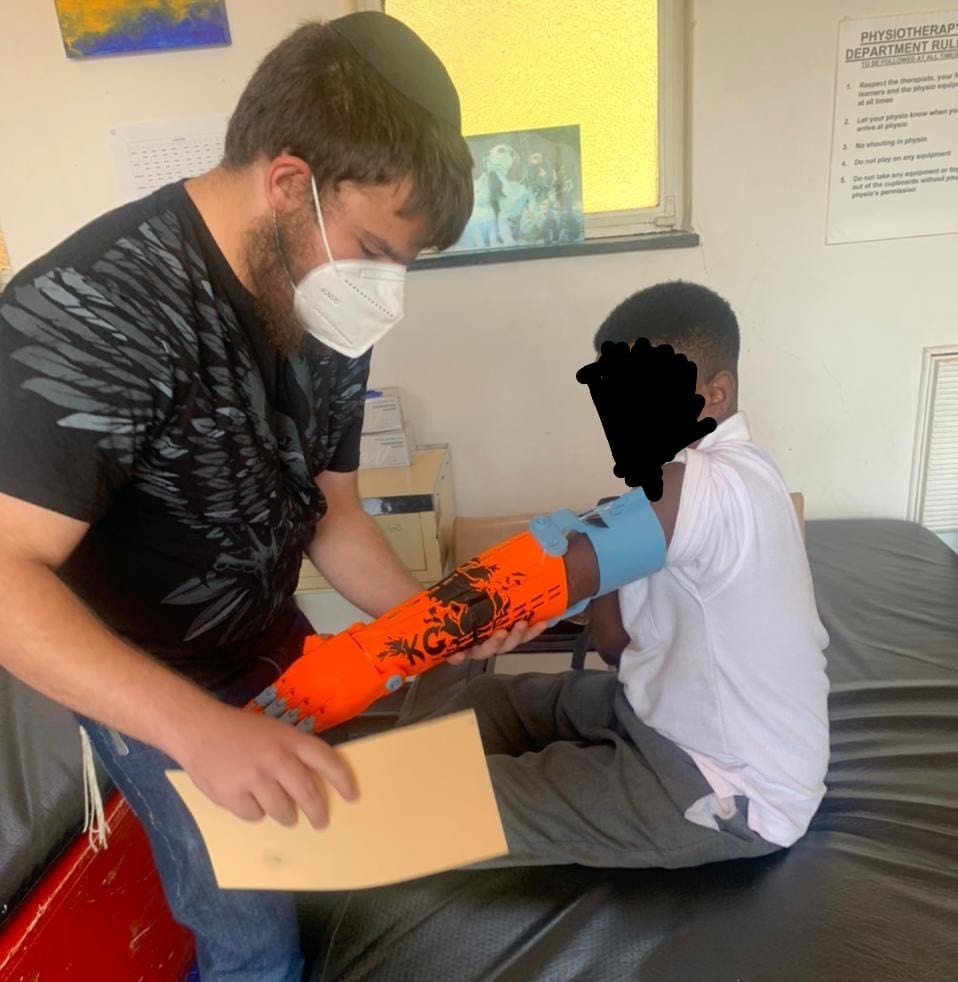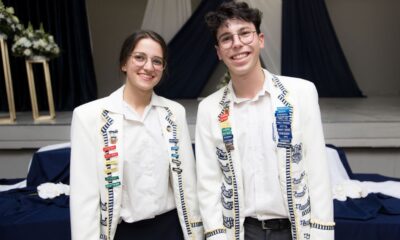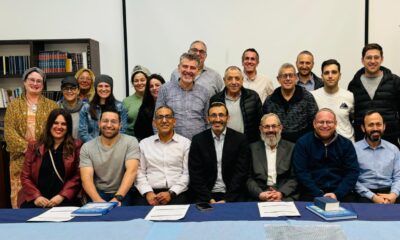
Community

Yeshiva schoolboy reaches out with 3D prosthetics
Published
9 months agoon
When 15-year-old Owethu, a pupil at Hope School for the physically disabled, was for the first time about to hold something with the 3D printed prosthetic hand that Yeshiva College matric pupil Saul Fox created for him, he was overwhelmed. It had been about seven years since he was able to hold anything with his left hand.
Owethu, whose surname has been withheld to protect him, hasn’t been able to do much with his limbs since he had to have his two legs, his left hand, and a number of fingers on his right hand amputated on 9 March 2016 after he developed septicemia of his digits.
So, Fox’s prosthetic hand has been a life-changer for him. For people without medical aid, there’s a three to six-year waiting list in Gauteng and about an eight to 10-year wait in the Western Cape for prosthetics, according to Fox, “and leg prosthetics are prioritised over arm prosthetics”.
“Where it costs us about R800 for a smaller arm or a larger hand, for someone to buy an actual prosthetic and get it fitted can cost upwards of R60 000,” says Fox. “I mean, they aren’t perfect replacements, but they work.”
Owethu, who has got more used to using his 3D prosthetic, says he likes the colour and design of the hand. “It can actually pick up things. I love it so much.”
Fox always knew he wanted to do biomedical engineering, but he didn’t realise he would do it before he left school until he started making 3D prints of upper-limb prosthetics for those in need.
“It started back in the beginning of Grade 11, when Yeshiva got a 3D printer,” he says. “One of the designs I found was Freddie Krueger Halloween, which was a finger extension that was semi-controllable. When I saw it, I thought, ‘Well, if you can use it to give longer fingers to someone who has fingers, could you not apply the same idea to someone who has no fingers and give them fingers?’”
After doing some research, he found an organisation called e-NABLE, which encourages people with 3D printers all over the world to print low-cost prosthetic upper-limb devices. However, he found that there was “barely anyone” doing it in South Africa.
After practising on the school’s printer and later a friend’s 3D printer, Fox eventually managed to get his own 3D printer. The prints are made from PETG, an oil-based plastic which is recyclable. The flexible parts which control the moving parts of the limbs are made from TPR (thermoplastic rubber). They are constructed through fused deposition modelling, which lays down layers of plastic and fuses it together. They also have a couple of screws and some catgut for movement.
The prosthetic is fitted to the hand of the person who has lost their fingers or the arm of the person has lost everything below the wrist, and the fingers move using elasticated parts that allow them to snap back into place. Those who have lost their fingers can use their knuckles to actuate the limb, whereas those who have lost their whole hand can use their elbow.
Fox says they had to go through test prints and a lot of research to ensure that the prosthetics would actually work. “Next thing, I was touring Netcare – Afrikaans poetry book in hand – talking to a paediatric surgeon about whether or not these are actually good devices, whether or not they can function, and whether they’re worth spending time on or if they’re just hopes and dreams.
“Loadshedding is a big holdup,” says Fox. “These are 15-hour-long prints, and if you stop in the middle, it’s ruined.” He has now set up a backup power system. “Once I’m finished matric and once we’ve got the backup power and such sorted, we could be doing as many as three prints a week,” he says.
He also consulted Michael Stevens, who runs a non-profit organisation called Jumping Kids which provides mobility equipment for children, specifically lower-limb amputees or those with lower-limb deformities.
Stevens was impressed with what Fox was doing, and believes there’s a lot of potential for the future of 3D-printed upper-limb prosthetics, more so than lower-limb prosthetics. “Using 3D printing, you can get these things done quite quickly and at a reasonable cost. It’s also helpful for getting kids used to wearing some sort of device. It’s the type of thing where, as the biomechanics and sensors progress, it will be more effective and the results will improve,” he says. “It also allows prosthetists to experiment and gives kids options. It might be for something as simple as riding a bike, where you can create a simpler solution for the kid.”
Stevens put Fox in touch with people from Hope School, where he met Owethu and a couple of other children whom he hopes to help soon.
“We’re still on the first patient because we’re trying to be careful and go slowly because if we start giving five people prosthetics and then we can’t keep up with repairing and maintaining them, it will be an issue,” says Fox.
Kerri-Ann Ramessar, a physiotherapist at Hope School, says that when Fox first approached her, she thought his ideas “looked really amazing, and what he was doing was something our pupils could benefit from”.
“During the first visit, he identified about five or six pupils, but since then two have left the school because they matriculated. He’s working with the younger kids for now so that he still has time to work with them.
“He came in, measured them, looked at what they would need, asked them what kind of prosthetic they would benefit from, and then offered them a whole range of colours and graphics to choose from. I thought that was nice because for younger kids, if it’s exciting, they want to wear it,” Ramessar says.
In her 12 years of physiotherapy, she has worked only with lower-limb prosthetics. “Saul is the first person I’ve come across locally that makes upper-limb prosthetics. So that in itself is quite unique,” she says. “What’s also amazing is how quickly it’s made, although it also makes it a little bit more fragile than a metal prosthetic, so that’s something to consider.
“He has also made adjustments as he needs to because he’s also finding his feet, learning, and growing. He lets the kid wear the prosthetic and then, if something breaks, I send him a picture and tell him what happened or how the injury occurred, and then he makes the necessary adjustments and brings it back for the kid. It’s a learning experience for all of us,” says Ramessar.
“He’s going to go really far, especially once he identifies the flaws and makes the adjustments. A lot of people will approach him, even privately, to get a prosthetic made.”
Fox’s dream is to get more people around the country involved, and to have a network of volunteers. “These aren’t my designs. I wasn’t the first person to come up with this idea, but the point of e-NABLE and its community is that if you have a 3D printer and you can find someone who needs a prosthetic, you can print them a prosthetic. You don’t need a ton of time or a ton of qualifications, you just need a little bit of practice and dedication.”










